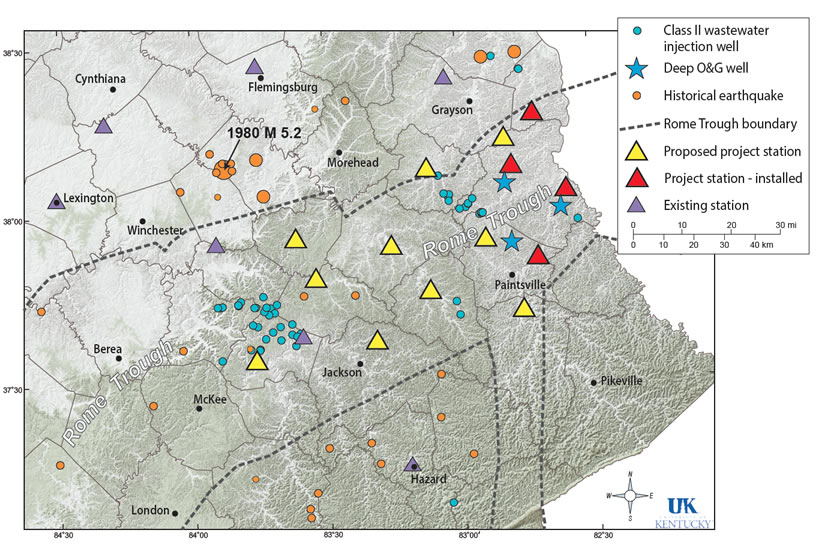

A Microseismicity Monitoring Network
Oil and gas development activities in several central U.S. states have been linked to cases of induced seismicity. Though no such events are known to have occurred in Kentucky to date, KGS is proactively responding to the issue by conducting a collaborative research project featuring the installation of a temporary network of sensitive seismographs in eastern Kentucky. The project area, encompassed by the Rome Trough geologic structure, has ongoing oil and gas development, with the potential for deep, unconventional shale plays, and existing Class II wastewater injection fields. Figure 1 shows the boundaries of the Rome Trough, locations of Class II injection wells, epicenters of historical (natural) earthquakes, and proposed locations of stations in the enhanced monitoring network.

Figure 1. Locations of proposed monitoring stations to be operated by KGS and by project partner Nanometrics,
existing seismic stations, historical earthquakes (epicenter of the 1980 magnitude 5.2 earthquake is labeled),
Class II wastewater injection wells, and deep production wells in Lawrence and Johnson Counties.
The boundary of the Rome Trough is delineated by dashed lines.
Project Motivation
It is important to perform a high-resolution study of microseismicity in eastern Kentucky because of the interest in developing deep shale gas plays, and because the effects of disposal of wastewater in deep injection wells in the heavily faulted Rome Trough of Kentucky are largely unknown. In addition, this part of eastern Kentucky is known to have moderate natural earthquakes, such as the 1980 magnitude-5.2 Sharpsburg earthquake (Fig. 1).
A detailed study of induced seismicity in eastern Kentucky is necessary to:
Regional Cases of Seismicity Induced by Fracking and Wastewater Injection
With the increase in hydrocarbon production using fracture stimulation (fracking), the rate of small to moderate earthquake occurrences in the central and eastern United States has increased compared to the long-term average rate (Ellsworth, 2013). Recent studies have demonstrated a tie between oil and gas activities and some felt earthquakes. In particular, earthquakes have been induced or "triggered" in the vicinity of hydraulic fracturing operations (see, for example, Friberg and others, 2014; Skoumal and others, 2015) and near wells used for the disposal of wastewater (Horton, 2012; Keranen and others, 2014). Earthquakes induced by fracking and by wastewater injection have been identified in many states, including several surrounding Kentucky: Arkansas, Indiana-Illinois border, Ohio, and West Virginia.
Induced seismic events occur regularly in Kentucky from mine blasts in the Eastern and Western Kentucky Coal Fields (Street and others, 2002). According to a recently published KGS Fact Sheet on induced seismicity in Kentucky, there have been no known cases of earthquakes induced by fracking or wastewater injection in Kentucky being either felt by people or detected by the Kentucky Seismic and Strong-Motion Network. This is likely a result of the low volumes of fluids used in either hydraulic- or nitrogen-based stimulations historically conducted in Kentucky, and a lack of seismic monitoring stations in the immediate vicinity of the injection activities. Development of the Rogersville Shale in the Rome Trough of eastern Kentucky would entail high-volume hydraulic stimulation.
Project Collaboration and Partnerships
The Earth and Environmental Sciences Department at the University of Kentucky has joined KGS to conduct this study. Also, Nanometrics, an instrument manufacturer with extensive experience in seismic monitoring around oil and gas operations, has agreed to match at least the number of stations that KGS purchases for this study, thus greatly increasing the sensitivity of the monitoring network.
In addition, KGS and the Earth and Environmental Sciences Department are seeking other partners, including industry, to join in this study. Support from such partnerships will further increase the resolution of the study and can benefit the long-term operations of the Kentucky Seismic and Strong-Motion Network in the state.
Contact
Please contact Seth Carpenter (895-323-0563; seth.carpenter@uky.edu) with questions related to this project or if interested in becoming a project partner.
References Cited